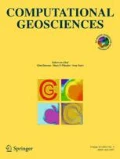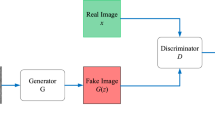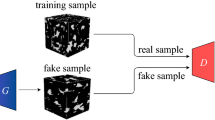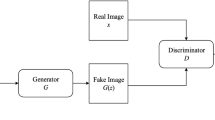Abstract
The accurate reconstruction of porous media is difficult to accomplish in practical research due to the intricacy of the internal structure of porous media, which cannot be described only using some equations or languages. The emerging deep learning methods open up a new research field for the reconstruction of porous media. One of the classic deep learning methods is generative adversarial network (GAN), which has been applied to the reconstruction of porous media, but also requires sufficient training samples as well as a long simulation process. Some GAN’s variants, such as the single-image GAN (SinGAN), are proposed to achieve desired results with only one training image (TI), but its serial structure still necessitates lengthy training time. Based on SinGAN, a stochastic reconstruction method of porous media combining attention mechanisms with multiple-stage GAN is proposed, focusing on important features of porous media with a single TI to achieve favorable simulation quality and using two discriminators to maintain enough diversity (one discriminator prefers real data, and the other favors fake data). Experiments prove that our method outperforms some numerical reconstruction methods and SinGAN in terms of practicality and efficiency.
Similar content being viewed by others
Data and code availability
The data and code used to support this study are available from the corresponding author upon request.
References
Arjovsky, M., Chintala, S., Bottou, L.: Wasserstein GAN. arXiv preprint arXiv:1701.07875. (2017)
Avizo: Avizo User’s Guide, 9th ed (2015)
Beucher, H., Renard, D.: Truncated Gaussian and derived methods. C.R. Geosci 348(7), 510–519 (2015)
Blunt, M.J.: Multiphase flow in Permeable Media: A pore-scale Perspective. Cambridge University Press, Cambridge (2017)
Cao, W., Feng, Z., Zhang, D., Huang, Y.: Facial expression recognition via a CBAM embedded network. Procedia Comput. Sci 174, 463–477 (2020)
Costanza, R.M.S., Estabrook, B.D., Fouhey, D.F.: Representative elementary volume estimation for porosity, moisture saturation, and air-water interfacial areas in unsaturated porous media: Data quality implications. Water Resource Res 47(7), W07513 (2011). https://doi.org/10.1029/2010WR009655
Feng, J.X., Teng, Q.Z., Li, B., He, X.H., Chen, H.G., Li, Y.: An end-to-end three-dimensional reconstruction framework of porous media from a single two-dimensional image based on deep learning. Comput. Methods Appl. Mech. Eng 368, 113043 (2020). https://doi.org/10.1016/j.cma.2020.113043
Goodfellow, I.: NIPS Tutorial: Generative Adversarial Networks. arXiv preprintarXiv:1701.00160 (2016)
Goodfellow, I., Pouget-Abadie, J., Mirza, M., Xu, B., Warde-Farley, D., Ozair, S., Courville, A., Bengio, Y.: Generative adversarial nets. In: Advances in Neural Information Processing Systems, pp. 2672–2680. Springer, Berlin (2014)
Guan, K.M., Anderson, T.I., Creux, P., Kovscek, A.R.: Reconstructing porous media using generative flow networks. Comput. Geosci 156, 104905 (2021)
Gulrajani, I., Ahmed, F., Arjovsky, M., Dumoulin, V., Courville, A.C.: Improved training of Wasserstein GANs. NIPS. arXiv:1704.00028 (2017)
Hazlett, R.D.: Statistical characterization and stochastic modeling of pore networks in relation to fluid flow. Math. Geol 29(6), 801–822 (1997)
He, Y., Chen, D.: Sequential indicator simulation and indicator kriging estimation of 3-dimensional soil textures. Aust J. Soil. Res 47(6), 622–631 (2009)
Heusel, M., Ramsauer, H., Unterthiner, T., Nessler, B., Hochreiter, S.: GANs trained by a two Time-Scale update rule converge to a local Nash Equilibrium. arXiv:1706.08500 (2017)
Hinz, T., Fisher, M., Wang, O., Wermter, S.: Improved techniques for training Single-Image GANs. arXiv:2003.11512 (2020)
Hou, J., Zhang, S.K., Sun, R.Y., Li, Z.Q., Li, Y.B.: Reconstruction of 3D network model through CT scanning. In: 69th European association of geoscientists and engineers conference and exhibition 2007: securing the future. Incorporating SPE EUROPEC. 6, 3398–3408 (2007)
Iglauer, S., Paluszny, A., Blunt, M.J.: Simultaneous oil recovery and residual gas storage: A pore-level analysis using in situ X-ray micro-tomography. Fuel 103, 905–914 (2013)
Itti, L., Koch, C.: Computational modelling of visual attention. Nat. Rev. Neurosci. 2(3), 194–203, arXiv Preprint arXiv: 1409.0473 (2001)
Jiao, Y., Stillinger, F.H., Torquato, S.A.: A superior descriptor of random textures and its predictive capacity. Proc. Natl. Acad. Sci 106(42), 17634–17639 (2009)
Kamrava, S., Mirzaee, H.: End-to-end three-dimensional designing of complex disordered materials from limited data using machine learning. Phys Phys. Rev. E 106(5), 055301 (2022)
Karras, T., Aila, T., Laine, S., Lehtinen, J.: Progressive growing of GANs for improved quality, stability, and variation. arXiv Preprint arXiv:1710.10196 (2017)
Krishnan, S., Journel, A.G.: Spatial connectivity: From variograms to multiple-point measures. Math. Geol 35(8), 915–925 (2003)
Lee, K.H., Yun, G.J.: Microstructure reconstruction using diffusion-based generative models. arXiv preprint arXiv:2211.10949 (2022)
Legland, D., Kiêu, K., Devaux, M.F.: Computation of Minkowski measures on 2D and 3D binary images. Image Anal. Stereology 26(2), 83–92 (2007)
Legland, D., Arganda-Carreras, I., Andrey, P.: MorphoLibJ: Integrated library and plugins for mathematical morphology with ImageJ. Bioinformatics 32(22), 3532–3534 (2016)
Lin, W., Li, X.Z., Yang, Z.M., Wang, J., Xiong, S.C., Luo, Y.T., Wu, G.M.: Construction of dual pore 3-D digital cores with a hybrid method combined with physical experiment method and numerical reconstruction method. Transp. Porous Media 120(1), 227–238 (2017)
Liu, M., Mukerji, T.: Multiscale fusion of digital rock images based on deep generative adversarial networks. Geophys. Res. Lett. 49(9), e2022GL098342 (2022)
Lymberopoulos, D.P., Payatakes, A.C.: Derivation of topological, geometrical, and correlational properties of porous media from pore-chart analysis of serial section data. J. Colloid Interface Sci 150(1), 61–80 (1992)
Mahmud, K., Mariethoz, G., Caers, J., Tahmasebi, P., Baker, A.: Simulation of Earth textures by conditional image quilting. Water Resour. Res 50, 3088–3107 (2014)
Mecke, K., Arns, C.H.: Fluids in porous media: A morphometric approach. J. Phys.: Condens. Matter 17(9), S503 (2005)
Mnih, V., Heess, N., Graves, A., Kavukcuoglu, K.: Recurrent models of visual attention. Adv. Neural Inf. Process. Syst 3, 2204–2212 (2014)
Mosser, L., Dubrule, O., Blunt, M.J.: Reconstruction of three-dimensional porous media using generative adversarial neural networks. Phys. Rev. E 96(4), 043309 (2017)
Nguyen, T., Le, T., Vu, H., Phung, D.: Dual discriminator generative adversarial nets. arXiv preprint arXiv:1709.03831 (2017)
Nowozin, S., Cseke, B., Tomioka, R.: f-gan: Training generative neural samplers using variational divergence minimization. Adv. Neural. Inf. Process. Syst 29, 271–279 (2016)
Okabe, H., Blunt, M.J.: Pore space reconstruction using multiple-point statistics. J. Pet. Sci. Eng 46(1–2), 121–137 (2005)
Otsu, N.: A threshold selection method from gray-level histograms. IEEE Trans. Syst. Man Cybernetics 9(1), 62–66 (1979)
Rajon, D.A., Bolch, W.E.: Marching cube algorithm: Review and trilinear interpolation adaptation for image-based dosimetric models. Comput. Med. Imaging Graph 27(5), 411–435 (2003)
Scholz, C., Wirner, F., Klatt, M.A., Hirneise, D., Schröder-Turk, G.E., Mecke, K., Bechinger, C.: Direct relations between morphology and transport in Boolean models. Phys. Rev. E 92(4), 043023 (2015)
Serra, J.: Image Analysis and Mathematical Morphology. Academic Press, London (1982)
Shaham, T.R., Dekel, T., Michaeli, T.: Singan: learning a generative model from a single natural image. Proc. IEEE Int. Conference Computer Vision. 4570–4580 (2019)
Song, S., Mukerji, T., Hou, J.: Geological facies modeling based on progressive growing of Generative Adversarial Networks (GANs). Comput. GeoSci 25, 1251–1273 (2021). https://doi.org/10.1007/s10596-021-10059-w
Song, S., Mukerji, T., Hou, J.: GANSim: Conditional facies simulation using an improved progressive growing of generative adversarial networks (GANs). Math. Geosci 53(7), 1413–1444 (2021). https://doi.org/10.1007/s11004-021-09934-0
Song, S., Mukerji, T., Hou, J., Zhang, D., Lyu, X.: GANSim-3D for conditional geomodeling: Theory and field application. Water Resour. Res. 58(7), e2021WR031865 (2022). https://doi.org/10.1029/2021WR031865
Song, S., Mukerji, T., Hou, J.: Bridging the gap between geophysics and geology with generative adversarial networks (GANs). IEEE Trans. Geosci. Remote Sens 60, 1–11 (2022). https://doi.org/10.1109/TGRS.2021.3066975
Strebelle, S.: Conditional simulation of complex geological structures using multiple-point statistics. Math. Geol 34(1), 1–21 (2002)
Theis, L., Oord, A., Bethge, M.: A note on the evaluation of generative models. arXiv preprint arXiv:1511.01844 (2015)
Tomutsa, L., Silin, D.B., Radmilovic, V.: Analysis of chalk petrophysical properties by means of submicron-scale pore imaging and modeling. SPE Reserv. Eval Eng 10(3), 285–293 (2007)
Volkhonskiy, D., Muravleva, E., Sudakov, O., Orlov, D., Krutko, V., Burnaev, E., Koroteev, D.: Reconstruction of 3D porous media from 2D Slices. arXiv:1901.10233v3 (2019)
Wang, Y., Zhang, Z., Feng, L., Ma, Y., Du, Q.: A new attention-based CNN approach for crop mapping using time series Sentinel-2 images. Comput. Electron. Agric. 184, 106090 (2021)
Woo, S., Park, J., Lee, J.Y., Kweon, I.S.: CBAM: convolutional block attention module. In: Proceedings of the European conference on computer vision. ECCV, pp. 3–19 (2018)
Wu, J., Nunan, N., Crawford, J.W., Young, I.M., Ritz, K.: An efficient Markov chain model for the simulation of heterogeneous soil structure. Soil Sci. Soc. Am. J 68(2), 346–351 (2004)
Xu, K., Ba, J., Kiros, R., Cho, K., Courville, A., Salakhudinov, R., Zemel, R., Bengio, Y.: Show, attend and tell: Neural image caption generation with visual attention. International Conference on Machine Learning, pp. 2048–2057 (2015)
Xu, W.Z., Xiao, C.Q., Jia, Z.R., Han, Y.P.: Digital image denoising method based on mean filter. International Conference on Computer Engineering and, Application: (ICCEA), Guangzhou, China, pp. 857–859 (2020)
Zhang, T., Du, Y., Huang, T., Yang, J., Lu, F., Li, X.: Reconstruction of porous media using ISOMAP-based MPS. Stoch. Env Res. Risk Assess 30(1), 395–412 (2016)
Zheng, Q., Zhang, D.X.: Digital rock reconstruction with user-defined properties using conditional generative adversarial networks. Transp. Porous Media 144, 255–281 (2022)
Funding
This work is supported by the National Natural Science Foundation of China (Nos. 41672114, 41702148).
Author information
Authors and Affiliations
Corresponding author
Ethics declarations
On behalf of, and having obtained permission from all the authors, I declare that:
• The manuscript has not been submitted to more than one journal for simultaneous consideration.
• The manuscript has not been published previously (partly or in full).
• Our study is not split up into several parts to increase the quantity of submissions and submitted to various journals or to one journal over time.
• No data have been fabricated or manipulated (including images) to support our conclusions.
• No data, text, or theories by others are presented as if they were the author’s own. Proper acknowledgements have been given.
• Consent to submit has been received explicitly from all co-authors, as well as from the responsible authorities, before the work is submitted.
• Authors whose names appear on the submission have contributed sufficiently to the scientific work and therefore share collective responsibility and accountability for the results.
• We have ensured the correct author group, corresponding author, and order of authors before submission.
The sources of funding have been listed in funding information. Our research did not involve human participants or animals. I testify to the accuracy of the above on behalf of all the authors.
Fangfang Lu (corresponding author).
20-August-2022.
Conflicts of interest/Competing interests
The authors declare that they have no conflict of interest.
Additional information
Publisher’s note
Springer Nature remains neutral with regard to jurisdictional claims in published maps and institutional affiliations.
Rights and permissions
Springer Nature or its licensor (e.g. a society or other partner) holds exclusive rights to this article under a publishing agreement with the author(s) or other rightsholder(s); author self-archiving of the accepted manuscript version of this article is solely governed by the terms of such publishing agreement and applicable law.
About this article
Cite this article
Zhang, T., Zhu, P. & Lu, F. Stochastic reconstruction of porous media based on attention mechanisms and multi-stage generative adversarial network. Comput Geosci 27, 515–536 (2023). https://doi.org/10.1007/s10596-023-10208-3
Received:
Accepted:
Published:
Issue Date:
DOI: https://doi.org/10.1007/s10596-023-10208-3




